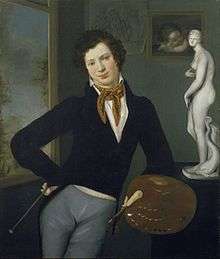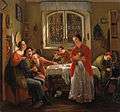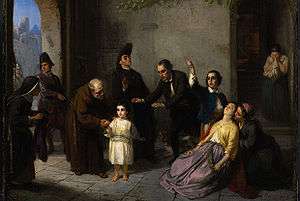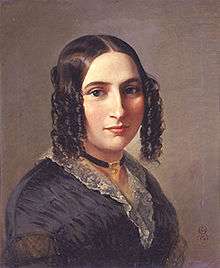Moritz Daniel Oppenheim
Moritz Daniel Oppenheim (January 7, 1800 in Hanau, Germany – February 26, 1882 in Frankfurt am Main) was a German painter who is often regarded as the first Jewish painter of the modern era. His work was informed by his cultural and religious roots at a time when many of his German Jewish contemporaries chose to convert to Christianity. Oppenheim is considered by the scholar Ismar Schorsch to be in sympathy with the ideals of the Wissenschaft des Judentums movement, because he remained "fair to the present" without denying his past.
Moritz Daniel Oppenheim | |
|---|---|
 Self portrait c. 1815 | |
| Born | January 7, 1800 Hanau, Germany |
| Died | February 26, 1882 (aged 82) Frankfurt am Main, Germany |
| Nationality | German |
| Education | Conrad Westermayr, Jean-Baptiste Regnault, Bertel Thorwaldsen, Barthold Georg Niebuhr, Friedrich Overbeck |
| Known for | Painting |
Notable work | Return of the Jewish Volunteer, The Kidnapping of Edgardo Mortara, Mignon and the Harper, Italian Genre Scene, Confirmation, Sabbath Blessing |
Biography
Oppenheim was born to Jewish parents at Hanau, Germany in 1800; he died at Frankfurt am Main in 1882. His niece was the wife of student and fellow painter Benjamin Prins, Rosa Benari.
He received his first lessons in painting from Conrad Westermayr, in Hanau, and entered the Munich Academy of Arts at the age of seventeen. Later he visited Paris, where Jean-Baptiste Regnault became his teacher, and then went to Rome, where he studied with Bertel Thorwaldsen, Barthold Georg Niebuhr, and Johann Friedrich Overbeck. There he studied the life of the Jewish ghetto and made sketches of the various phases of its domestic and religious life, in preparation for several large canvases which he painted upon his return to Germany. In 1825 he settled at Frankfurt, and shortly after exhibited his painting David Playing Before Saul, to see which a great number of admirers from all parts of Europe visited his studio. In 1832, at the instance of Goethe, Charles Frederick, Grand Duke of Saxe-Weimar-Eisenach conferred upon him the honorary title of professor. Oppenheim was commissioned to paint several portraits of prominent members of the Rothschild banking dynasty.[1] Oppenheim portrayed his also his grandson Alfred Oppenheim, who became also a well known artist.
Oppenheim taught at the Städel Institute, where Julius Bien was one of his students.[2]
Selected works
Oppenheim's studies of Jewish life, his pictures of Emperor Joseph II and Moses Mendelssohn, and his portraits from life of Ludwig Börne and other contemporary Jewish notables, established his reputation as one of the foremost Jewish artists of the nineteenth century. His Return of the Jewish Volunteer is among his most famous works and was frequently reproduced; others include Mignon and the Harper, Italian Genre Scene, Confirmation, and Sabbath Blessing. All these are characteristic examples of his power of conception and skill at grouping.
 The Return of the Jewish Volunteer from the Wars of Liberation to His Family Still Living According to Old Customs (1833-34)
The Return of the Jewish Volunteer from the Wars of Liberation to His Family Still Living According to Old Customs (1833-34)
 Portrait of Leopold Zunz
Portrait of Leopold Zunz Portrait of Fanny Hensel (1842)
Portrait of Fanny Hensel (1842)
References
- Five Arrows, Rothschild Archive
- Morgan, Ann Lee (1987). "The American Audubons: Julius Bien's Lithographed Edition". Print Quarterly. 4 (4): 362–79. JSTOR 41823786.

- Jewish Expression in Twentieth-Century Fine Arts
- Moritz Daniel Oppenheim in the German National Library catalogue
- Museen Hanau: Die Entdeckung des jüdischen Selbstbewußtseins in der Kunst
- Georg Heuberger/Anton Merk: Die Entdeckung des jüdischen Selbstbewußtseins in der Kunst
- Der Zyklus "Bilder aus dem altjüdischen Familienleben" und sein Maler
- Georg Heuberger/Anton Merk: Moritz Daniel Oppenheim: Die Entdeckung des jüdischen Selbstbewußtseins in der Kunst. Wienand Verlag 1999.
- Claus Stephani: Das Bild des Juden in der modernen Malerei. Eine Einführung. / Imaginea evreului în pictura modernă. Studiu introductiv. Traducere în limba română de Ion Peleanu. (Zweisprachige Ausgabe, deutsch-rumänisch. Ediţie bilingvă, româno-germană.) Editura Hasefer: Bucureşti, 2005. ISBN 973-630-091-9
- Ruth Dröse, Frank Eisermann, Monica Kingreen, Anton Merk: Der Zyklus "Bilder aus dem altjüdischen Familienleben" und sein Maler Moritz Daniel Oppenheim. CoCon-Verlag Hanau. ISBN 3-928100-36-X
External links
| Wikimedia Commons has media related to Moritz Daniel Oppenheim. |
- The Wedding, 1861 – Moritz Oppenheim The Israel Museum, Jerusalem
- Moritz Daniel Oppenheim – the First Jewish Painter, trailor of a documentary
- Moritz Daniel Oppenheim in the Jewish Museum Frankfurt